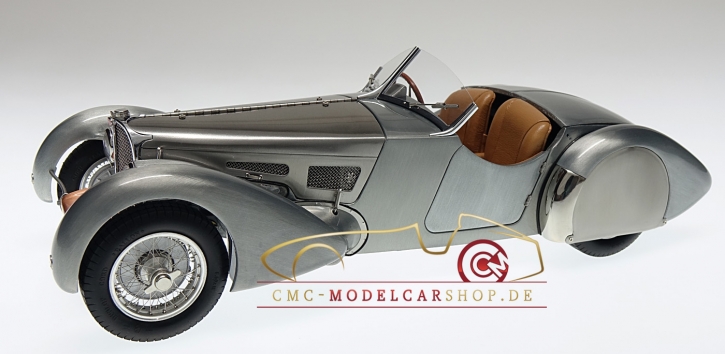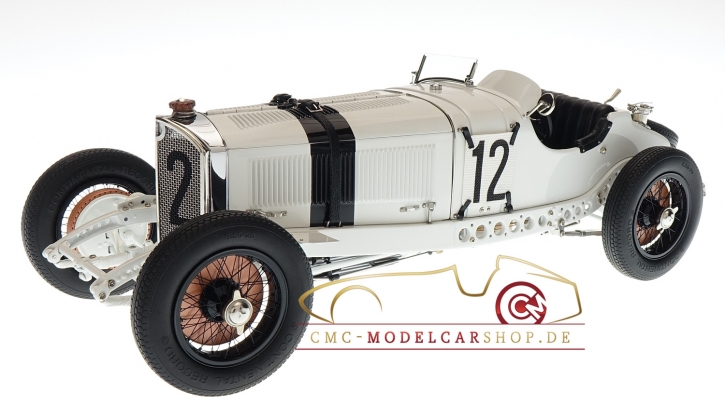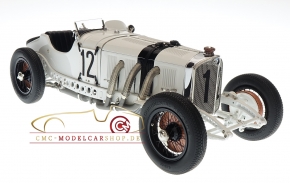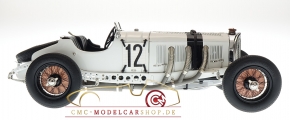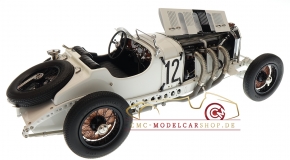product description
CMC has already replicated Caracciola‘s winning car with starting number 8. This year we would like to pay tribute to the achievements made by Otto Merz and Hans Stuck at the German Grand Prix on July 19, 1931. With that in mind, CMC will develop and make available authentic detailed replicas of their SSKL racers in 1:18 scale.
- Model: Precision model hand-assembled
- Manufacturer: CMC GmbH, Classic Model Cars, Germany
- Scale: 1:18
- Item-No.: M-189
- Parts: 1.885
- Limited Edition: 600
- Hand-mounted metal precision model of 1885 parts
- Authentically replicated and precisely scale car body
- True-to-the-original replicated of the light-weight steel frame with original bore hole pattern
- Metal cooler grill with rock-protection
- Double-leaf engine hood that opens from the right and left sides and is secured by a leather belt
- Functional hingers of the engine hood coiled with prings
- Vivacious miniaturisation of the 6-cylinder-inline engine with all aggregates, pipelines and cabeling
- Right-sided exhaust pipes made of flexible metal-hoses
- Masterly-crafted spoke wheels with aluminium-rims and stainless-steel spokes wired by hand
- Knock-off screws that enable the removal and fastening of wheels
- Removable spare wheels fastened by a toggle screw behind the cookpit
- Functional and authentically-replicated multi-layer metal compound spring on the front and rear axels
- Filler-neck with removable tank top made of stainless steel
- Steering wheel covered with genuine leather
- Both levers on the steering wheel (hand-accelerating an ignition timing) are movable
- True-to-the-original presentation of the cockpit, including both seats covered with leather and a nicely replicated dashboard with all instruments and control gadgets
- Movable windscreen for driver and co-driver
- Finned brake drums, created like the original with a fuel reserve can and a tool-box made of wood with a movable cover (mini tools inside)
- Folded top-cover wrapped up in a leather case and fixed by several leather-belts (not movable)
- Starting number 87 printed by the tampon printing method on the white painted car-body
The SSKL often went by the affectionate nickname of "White Elephant." On the one hand, this could be attributed to its seemingly unruly power and colossal size. On the other, it had much to do with the German racing livery that Rudolf Caracciola, Hans Stuck and Otto Merz had on their SSKLs and the plethora of honors they won in racing the SSKLs. Despite the global economic crisis and limited support from the Daimler-Benz factory in Stuttgart Untertürkheim, Rudolf Caracciola and his two teammates ma-naged to keep up their chins and brave through the hardships. In addition to his victory at the 1931 Mille Miglia, Caracciola finished first in the 1931 Grand Prix of Germany, whereas Otto Merz and Hans Stuck took a fifth and sixth places in the same race.
The race was held in two groups.
Group I was for vehicles over 1100 cc, which were to run 22 laps (22x 22.81 km), covering a total distance of 501.82 km.
Group II was for vehicles up to 1100 cc, which were to run 18 laps (18 x 22.81 km), equivalent to a total distance of 410.58 km.
All racing cars started off at the same time. It was assumed that the two groups would finish the race around the same time. To distinguish them visually for the pit crews and the spectators, Group I cars were marked with a wide black horizontal stripe over the hood, whereas Group II cars used a wide white stripe instead. Since many of the small-displacement race cars were native to Germany and had a white-finished body, the white stripes on them were outlined in a black color additionally.
The Mercedes team set itself up at the Nürburgring two weeks earlier. Before long, it buckled down to test driving under the direction of Alfred Neubauer. Apart from the practices of racing, the training program also included how to change tires with a newly-developed jack and manage the refueling process, etc. This type of training went so far that together with his mechanic, Caracciola was able to complete a tire change in a minute and 10 seconds. His teammates were not much slower.
48 entrants of Groups I and II from 10 different nations were ready to start off on the rainy day of July 19, 1931. Mercedes fielded its SSK and weight-reduced SSKL vehicles, and the latter were primarily saved for its famous pilots like Caracciola, Branditsch, Merz, Stuck, and Spandel. The main rivals were from the other well-known marques, such as Bugatti, Maserati and Alfa Romeo, which provided much lighter and better engineed vehicles to their internationally-renowned pilots, such as Chiron, Varzi, Fagioli or Nuvolari.
The race proved to be a clear win for Rudolf Caracciola, who dominated from the start to the finish. Only after the 13th lap, when it stopped raining, was Louis Chiron able to start undercutting Caracciola's lead in a Bugatti. But it was too late, for Caracciola was so far ahead. The other two Mercedes pilots, Otto Merz with starting number 12 and Hans Stuck with starting number 10, drove a consistent and canculated race to take the respectable fifth and sixth places.
- Six cylinder in-line-engine with overhead camshaft
- Compressor that can be activated when required
- Output without compressor: 240 hp at 3.300 rpm
- Output with activated compressor: 300 hp at 3.300 rpm
- Displacement: 7,056 ccm
- Top speed: 235 km/h
- Wheel base: 2,950 mm
- Total length: 4,250 mm
- Track front: 1,470 mm
- Track rear: 1,460 mm
Product safety - Manufacturer information (GPSR)
CMC GmbH & Co. KG, Stuttgarter Str. 106, 70736 Fellbach
Contact: www.cmc-modelcars.de
Sicherheitshinweis / Consigne sécurité / Safety warning:
Sammlermodell - Nicht für Kinder unter 14 Jahren geeignet
Modèle de collection - Ne convient pas aux enfants de moins de 14 ans.
Collector's model - Not suitable for children under 14 years of age
Review(s)
Wrote by Olivier T. on 10.05.2025
Un Bijou de réalisation
Ah si j 'avais la mēme grandeur nature dans mon garage !!!
Wrote by Philippe B. on 03.04.2023
second produit
tres beau produit -qualité tjr aussi remarquable .













